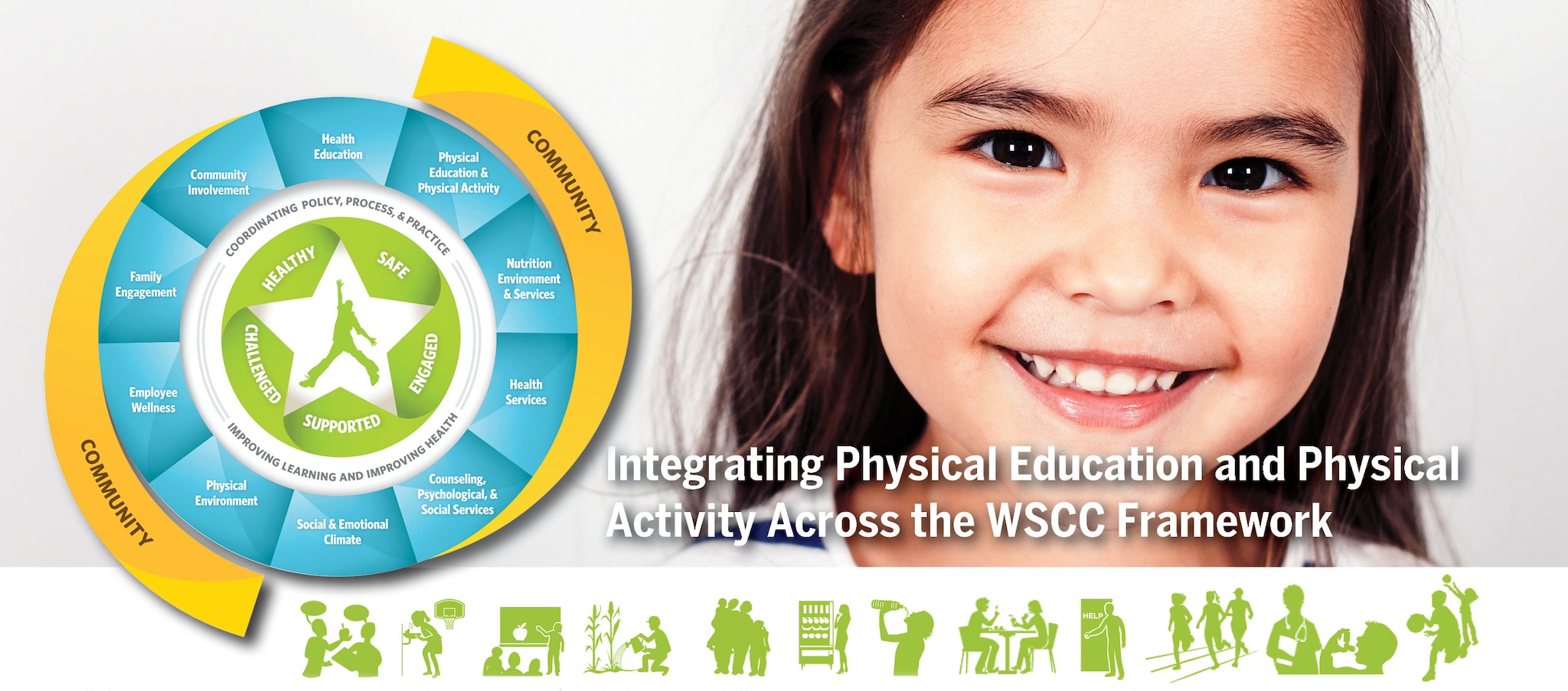At a glance
Learn about evidence-based ways to use CDC's Whole School, Whole Community, Whole Child (WSCC) framework for physical education and physical activity.

Integrating physical education and physical activity across the WSCC framework
Schools that provide physical education daily can give students the ability and confidence to be physically active for a lifetime. Here are some evidence-based strategies and promising practices for using the Whole School, Whole Community, Whole Child (WSCC) approach to promote physical education and physical activity across the school setting.
Physical education and physical activity
- Implement policies and practices that support a Comprehensive School Physical Activity Program, including physical education, recess, classroom physical activity, intramurals, physical activity clubs, walk- and bicycle-to-school initiatives, and interscholastic sports.
- Implement policies and practices that support physical education, such as:
- Requiring daily physical education.
- Having a written curriculum.
- Providing opportunities for certification licensure for PE teachers.
- Making sure students get moderate-to-vigorous physical activity for at least 50% of class time.
- Prohibiting the withholding of physical education or the use of physical activity as a punishment.
Health education
- Include physical activity as part of comprehensive health education.
- Ensure that health education curricula align with the national and state standards for physical education and address the physical activity behavior outcomes in CDC's Health Education Curriculum Analysis Tool.
- Reinforce the information taught in physical education classes and provide opportunities for students to apply it.
Community involvement
- Establish partnerships between schools and local government to create joint-use agreements to allow public access to school facilities, fitness centers, gymnasiums, or running tracks.
- Link to out-of-school programs that promote physical activity.
- Involve community organizations in school initiatives on physical education and physical activity.
- Leverage community resources to purchase equipment and safety gear, create safer environments for play such as safe playgrounds, and provide physically active transportation to school, such as traffic interventions.
Family engagement
- Provide materials about physical education and physical activity in languages that students and parents speak at home.
- Involve families on the school health council and engage them in promoting policies and practices for physical education and physical activity.
- Survey the interests of families to help offer needed physical activity initiatives.
- Encourage family members to volunteer in physical education classes or other physical activity programs.
Employee wellness
- Encourage school staff to model physical activity behaviors.
- Provide staff with access to physical activity opportunities through staff wellness programs.
- Provide physical activity breaks during staff meetings.
- Develop, implement, and evaluate physical activity programs for all school employees.
Physical environment
- Assess, inspect, and maintain all spaces and facilities for physical activity, including playing fields, playgrounds, gyms, swimming pools, multipurpose rooms, and fitness centers.
- Ensure safe routes to school.
- Provide safe and age-appropriate playgrounds and equipment for physical education, physical activity, and recess during the school day.
- Post safety rules and teach them to students.
- Provide students with protective clothing and equipment appropriate for the type of physical activity and the environment.
Social and emotional climate
- Establish social norms that increase physical activity behaviors of students and staff members, such as morning physical activity for all over intercom system.
- Establish policies and practices that allow full participation by all students in physical activity and physical education.
- Do not use physical activity as punishment or withhold opportunities for physical activity as a form of punishment.
Counseling, psychological, and social services
- Assess student needs related to physical activity and provide counseling and other services to meet those needs.
- Help students overcome barriers to physical activity and help them find social support, cope with teasing, set goals, and make healthy decisions.
Health services
- Refer students with physical activity concerns to health services staff members.
- Encourage collaboration between health staff members and physical education teachers to establish a healthy environment that promotes physical activity messages and activities.
- Implement individualized health plans established for students with chronic health conditions and encourage them to participate fully in structured and unstructured physical activity.
Nutrition environment and services
- Ensure access to free drinking water in the gym and other physical activity areas.
- Promote only healthy foods; physical activity, such as dance-a-thons; or nonfood items for school sports or physical education program fundraisers.
